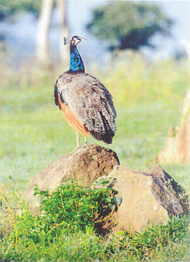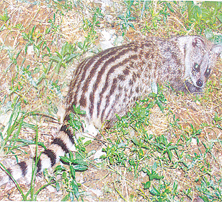|
What is Chennai now was once an integral part of the vast Tropical Dry Evergreen Forest (scrub jungle) of the Coromandel Coast. Chennai today is the only city in India to have a national park (Guindy National Park) in its midst. Hence, wildlife like the Chital (Spotted Deer), Slender Loris, Palm Civet (Toddy Cat), Star Tortoise and snakes straying into the city should be no wonder.

Peacock, after shedding tail feathers.
Photo: T. Murugavel
|
The scrub jungle of the Guindy National Park (GNP) and the contiguous Indian Institute of Technology (IIT) campus are remnants of the original Evergreen Forest. Today, the Blackbuck is indeed a flagship species of these two reserves. The other remnant of this fragmented scrub jungle is the campus of Madras Christian College (MCC) in Tambaram.
Wildlife in both these pockets is identical, but it is richer, more diverse, and ever-changing in the MCC scrub, because of the broad, dense corridor in the south leading to the Vandalur Reserve Forest. The rare Hammerhead worms, House centipedes, Sun spiders, Giant forest scorpions, Whip scorpions, Tail-less whip scorpions, Chameleons, Monitor lizards, 18 species of snakes, Star-tortoises, Pangolins, Honey badgers, Slender Loris, Bonnet Macaques, Civet cats, Palm Civets (Toddy Cats), Hedgehogs, and occasional Hyena, Leopard Cat and even Leopard are some of the wildlife on the MCC campus and the adjacent Indian Air Force campus.
Spotted Deer since 1982 and Peafowls since 2005 are new additions. Koels and Peacocks calling melodiously at dawn, Nightjars screeching at dusk and Jackals howling all through the night on the MCC campus make you feel, while you are in bed, as if you are sleeping in a wildlife sanctuary!

Civet Cat,
Photo: A. Lakshmikantan
|
The thickly vegetated campuses of the Theosophical Society (TS) and the Kalakshethra Colony on the east coast in Chennai are well developed and managed habitats, to which arboreal (tree-dwelling) wildlife like the Bonnet Macaque, Slender Loris, Palm Civet (Toddy Cat), Flying Fox, Vine Snake, Bronzeback Tree Snake, all scrub birds, and butterflies from the GNP-IIT Reserves migrate.
Nanmangalam scrub in the south is another small wildlife reserve, particularly for birds, but the rocky cliffs and caverns of the granite quarries provide a unique breeding niche for the rare Great Horned Owl. Similarly, the highrise buildings in Chennai today are attracting Rock Pigeons.
Chennai’s waterways are natural or habitual corridors for wildlife migration. Its grid of waterways opening into the Bay of Bengal contributes to a rich and diverse aquatic biodiversity. The 1933-36 foundation survey of the brackish water fauna of the Adyar Estuary showed about 140 species of aquatic fauna, including 55 species of fish and five species of rare Sea Anemones, three of which were new to science in 1936. But do they still exist in the Adyar Estuary? A 1982-83 study of the Cooum shows heavy pollution. Does any aquatic fauna survive in it?
Having two estuaries co-existing within a city is another rare feature in Chennai, but their mouth-openings into the sea must be permanently kept open, in order to be more productive. Satellite imageries of Greater Chennai reveal the connectivities of the vegetated patches and waterways, serving as wildlife reserves and corridors. Along the corridors of the waterways, jackals migrate at night, foraging for shore-crabs and scavenging for carcasses, if any.
The Buckingham Canal (East Coast Canal) is the best example of a water grid and water corridor in India, as it links four major rivers, 14 smaller rivulets, two large lagoons and several backwaters on the Coromandel Coast, and disperses their biodiversity – as well as their pollutants.
A 5-foot Salt Water Crocodile which intruded into the Buckingham Canal, near Mylapore, in June 1997 was unfortunately killed by the panicked hut-dwellers on the canal banks. In December 2006, a 4-foot Marsh Crocodile (Mugger) that strayed into a house in Peerkankaranai near Tambaram was, however, successfully rescued and rehabilitated by the Forest Department. People should be advised to contact the Wildlife Rescue and Rehabilitation Centres in Chennai (Tel: 2220 0335).
The Pallikaranai Marsh in the midst of the city is another wildlife reserve, but it is a closed aquatic ecosystem without any inlet or outlet waterways, so there is no exchange of flora and fauna and consequent enrichment of its biodiversity. However, the water lilies in the Pallikaranai Marsh and in the Madhavaram Jheel are the breeding sites for those rare and beautiful birds, the jacanas. Even from a drying-up private pond like the Mermaid Pond in the YWCA campus, an incredible number of 287 Pond Terrapins were rescued in March 2004!
Of a different category of water corridors are the underground sewage and stormwater drains. They harbour cockroaches, rats and bandicoots, all categorised as ‘Vermin’. Some parts of the city get Sewage Worms, Blood Worms and even tiny Snail-Leeches through their drinking water taps, perhaps through contamination from Hyacinth – or algae – infested tanks.
An “innate (instinctive) affinity of humans to all other living beings” has been recognised by scientists. This could be a reciprocal affinity too, as we see in dogs, cats, squirrels, house sparrows, rock pigeons and painted storks etc. a craving for proximity to human habitats. (Courtesy: Eco News, the journal of CPR Environmental Education Centre)
|